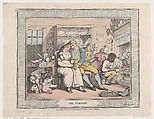The Nursery
Etcher Thomas Rowlandson British
After James Brydges Willyams British
Publisher Thomas Rowlandson British
Not on view
In this first print of a set of eight, a nursemaid ignores the infant in her care and drinks with a soldier who seems intent on seduction—lying helpless on the floor, the baby is soiled by a dog. Related text by Willyams, who also designed the image, proposes satirically that babies who are given to a wet nurse are much more likely to grow up healthy and strong than if carefull tended by loving parents.
"Then let the Child be early accustomed to every Species of Hardship and Inattention. Instead of being hushed into Quietness by the usual Means of Singing, Rocking, or lisping Nonsense, let it be encouraged in its natural and wholesome Propensity to Squalling, by impatient Chiding, passionate Slaps, and sly Pinches. Instead of lolling on the soft Lap of its sleek Nurse, let it sprawl on the hard Floor. Instead of being soothed by the Caresses of its doting mama, let it be clawed by the Cats, and licked by the Dogs; let it, in fine, be fashioned both bodily and mentally, according to the Laws and Customs of the Kitchen; and there is no Doubt that in a few Years (without the silly Interference of its Parents), the little Urchin will be perfectly fit for one of those Nurseries of Education, which promise, in large gold Characters, to rear the tender Plant to a more fertile Soil."
The author-designer was a university-educated lieutenant-colonel from Cornwall who also supplied supporting satirical text under the pseudonym Joel McCringer. Rowlandson, who etched the print, imbues the figures with his own characteristic elegance which does not disguise the dark human impulses being satirized.
Due to rights restrictions, this image cannot be enlarged, viewed at full screen, or downloaded.


